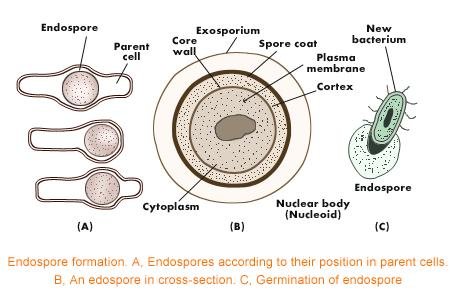Bacterial Spore – Basic microbiology, parasitology, and immunology; nature, reproduction, growth, and transmission of common microorganisms and parasites in Bangladesh; prevention including universal precaution and immunization, control, sterilization, and disinfection; and specimen collections and examination. Students will have an understanding of common organisms and parasites caused human diseases and acquire knowledge about the prevention and control of those organisms.
Bacterial Spore
Bacterial spores are highly resistant, dormant structures (i.e. no metabolic activity) formed in response to adverse environmental conditions. They help in the survival of the organisms during adverse environmental conditions; they do not have a role in reproduction.
Or
Spores are resistant stage of bacteria produced when bacteria are exposed to unfavorable environmental condition, and are highly resistant to heat, desiccation (dehydration), chemicals etc.
Classification of Spores;
A. Exospore : The spore which is formed outside the parent vegetative cell. Example: Fungal spores.
B. Endospore; The spore which is formed inside the parent vegetative cell.
Example: Bacterial spores.
a) According to the shape;
- Oval
- Spherical
b) According to the position;
- Terminal
- Sub-terminal
- Central
c) According to the size:
- Bulging: spore size is greater than the diameter of the body.
- Bulging: spore size is smaller than the diameter of the body.

Figure: Different types of bacterial Spore
Spore core; – It is homologous with protoplast of the vegetative cell, i.e.- it consists of cytoplasm and its contents. It is rich in calcium- dipicolinate, an important chemical for resistance property.
Inner membrane / Spore wall: It is homologous with the cell wall of the vegetative cell. It consists of usual peptidoglycan.
Spore cortex; It is the thickest layer of bacterial spore and contains unusual type of peptidoglycan.
Spore coat; It is the toughest layer (not thickest) of bacterial spore and consists of keratin-like protein. It provides resistance to heat, desiccation (dehydration) and various chemicals.
Exosporium; It is the outermost layer of bacterial spore. It contains lipoprotein with some carbohydrate.
Structure of Bacterial Spore:

Figure: A. Endospores according to their position in parent cells, B. An Endospore in cross-section, C. Germination of endospore.
Medical Importance of Bacterial Spores;
1. Spores are highly resistant structures, so it is difficult to kill them by antibiotic, chemicals or heat.
2. Spores are infective form of many bacteria, e.g. Clostridium tetani.
3. Spores are used as indicator of sterilization.
4. Spore can be destroyed by autoclaving & specially designed sporicidal solution.
Properties/Peculiarities of Bacterial Spore:
- Highly resistant to heating, are not killed by boiling (100°C), but are killed at 121°C
- Highly resistant to many chemicals, including most disinfectants, due to thick keratin like coat.
- They can survive for many years, especially in the soil.
- They exhibit no measurable metabolic activity.
- Spores are formed when nutrients are insufficient but then germinate when nutrients become available.
- Spores are produced by members of only two genera of bacteria of medical importance, Bacillus and Clostridium, both of which are gram-positive rod
Spore Bearing Micro-Organisms;
A. Spore-bearing bacteria :
a) Gram-positive bacilli:
- Clostridium tetani
- Clostridium botulinum
- Clostridium perfringens
- Bacillus anthracis
- Bacillus subtilis etc.
b) Gram Positive cocci;
- Sporosarcina
c) Gram-negative coccobacilli;
- Coxiella burnetii
B. Fungus;
a) Sexual spores;
- Zygospores
- Ascospores
- Basidiospores
b) Asexual spores
- Arthrospores: e.g. Coccidioides immitis
- Chlamydospores: e.g. Candida albicans
- Blastospores: e.g. Candida albicans
- Sporangiospores: e.g. Rhizopus, Mucor
Definition of Sporulation:
The process of formation of spore from the vegetative form of bacteria in adverse environmental condition is called sporulation.
Time of Occurring
- When there is depletion of the supply of nutrients for bacterial growth & multiplication.
Example: Depletion of C, N2, S04, P04 etc. - Adverse environmental condition such as excessive heat, cold, dehydration, radiation etc

Process Of Sporulation:
The following steps are involved:
Formation of axial filamenting
- Forespore septum formation
- Engulfment of forespore
- Cortex synthesis
- Coat deposition
- Maturation
- Lysis of mother cell
- Newly formed spore

Stages of endospore formation
Germination Of Spore:
Germination of spore means ‘formation of vegetative bacterial cell from the spore’ Germination occurs by enzymatic dissolution of the spore cortex when bacteria are exposed to favourable environmental condition.
Germination Process
- Figure: Activation: Activation occurs by heat, acidity or compounds containing free sulphydril groups.
- Initiation: It occurs when bacteria are exposed to favourable environmental condition.
- Outgrowth: Degradation of the cortex and outer layer of the spore by bacterial enzyme.
Causes of High Resistance of Spore;
- Due to presence of spore coat & spore cortex, which are impermeable to various destroying agents.
- Due to very low metabolic & enzymatic activity.
- Due to lower water content in cytoplasm.
- Due to presence of high level of calcium-dipicolinate.
Read More….
